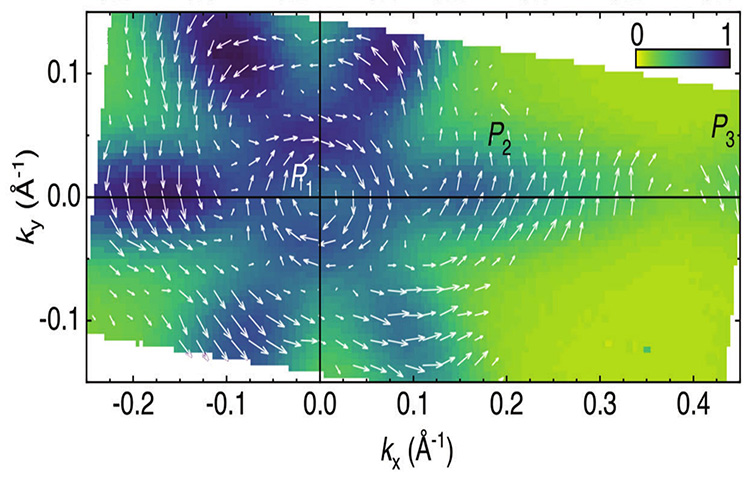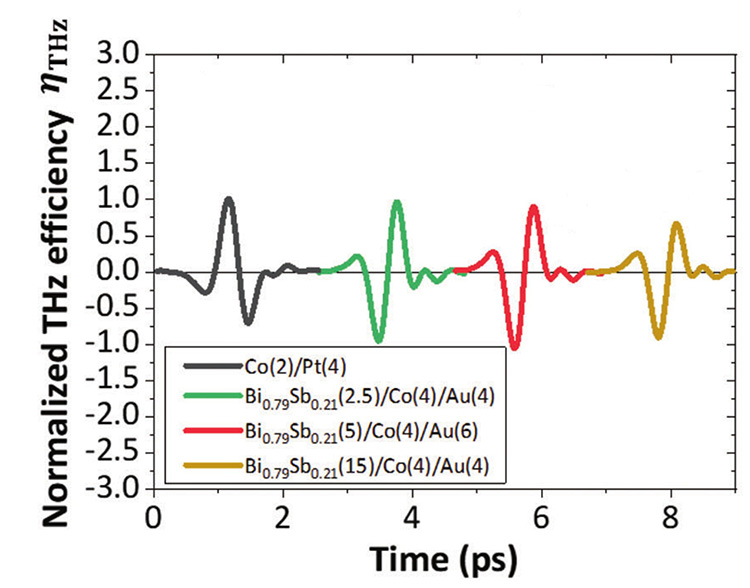As presented previously, topological insulators are electrically insulating materials, but whose surface (on some atomic layers) is conductive. At the CASSIOPEE beamline, studies on Bi1-xSbx alloys have demonstrated the existence of these metallic surface states. The final objective is to use these materials for spintronics, electronics that use the spin* of the electron in addition to its charge, with a view to developing components that consume less energy. The role of these materials would then be to convert conventional charge currents into spin currents, i.e. electrons whose spins are massively oriented in the same direction.
Spintronics, a field of study for specialized researchers some thirty years ago, is now the basis of many objects widely used by the general public: reading heads for magnetic hard disks or other ultra-sensitive sensors that invade our smartphones or our cars. By using the spin* of the electron in addition to its charge, spintronics mixes traditional electronics and magnetism.
The example of magnetic memories
Microelectronics companies are starting to market magnetic memories based on spintronics. To write information, a layer of magnetic material is magnetized in one direction ("0") or the other ("1"). These memories are therefore non-volatile and energy-efficient: the written information is robust and does not require current to be maintained. The reversal of the magnetization to write a new information is done by injecting a spin-polarized current (consisting of electrons whose spins are massively oriented either up or down) in the right direction into the layer. The problem is to be able to create these spin-polarized currents.
New materials for spintronics
This is where topological insulators come in. These materials are electrical insulators, but their surface (on some atomic planes) is conductive. The most peripheral electrons (very far from the atomic nuclei and therefore not very attached to the atoms) are free to circulate on the surface of the material. Confined to the first atomic planes of the material, they form a "two-dimensional metal". Their momentum (the vector indicating their direction of motion in classical mechanics) is therefore also parallel to the surface and can be described by two components (kx and ky).
Angle-resolved photoelectron spectroscopy allows to measure an "intensity map" of these surface states as a function of the kx and ky components, for electrons with zero binding energy (Fermi surface). As these kx and ky components are quantified, this map indicates which states are allowed for these most peripheral electrons of atoms.
Scientists from the Unité Mixte de Physique CNRS-Thalès, C2N and the CASSIOPEE beamline have previously shown that, in compounds of general formula Bi1-xSbx, this Fermi surface has the shape of a flower with six petals and a hexagonal core. Moreover, thanks to spin-resolved photoemission measurements performed at the CASSIOPEE beamline, they have highlighted the fact that, as predicted by the theory, this Fermi surface presents a spin texture, i.e. a regular arrangement of the spin direction for the observed electronic states. The result, obtained on a 5 nm thin film of Bi0.85Sb0.15, is presented on figure 1. For each pixel of the image, the two spin components have been measured along the two directions kx and ky. These two measurements are used here to represent the spin as a vector. A clockwise winding is observed around the center of the "flower" and a counter-clockwise one on its petals.

Figure 1: Spin texture of the Fermi surface in a 5 nm thin film of Bi0.85Sb0.15 alloydeposited on a silicon substrate, measured by angle and spin resolved photoemission. We can see a flower with a heart P1 and 6 petals P2. We can also see the beginning of a new series of petals (P3). For each pixel of the image the two components of the spin were measured along the two directions kx and ky. These two components are used to represent the spin as a vector.
Spin current / charge current conversion
This texture should allow to convert very efficiently a charge current into a spin current by the "Edelstein effect", a predicted and observed effect. The reverse conversion from spin current to charge current is also possible by the reverse Edelstein effect.
In order to test such a conversion capacity by the surface of this topological insulator, a layer of cobalt, a ferromagnetic material, has been deposited on it. In ferromagnetic materials, the electrons able of circulating naturally present unbalanced spin populations: there are more up spins than down spins, and this dissymmetry gives these materials their well-known property of permanent magnets.
A laser pulse was used to create a spin current pulse; if the conversion is efficient, a current pulse should be created across the topological insulator, causing an energy emission detectable by spectroscopy in the TeraHertz (THz) range. This THz spectroscopy was thus applied on a series of films of Co/Bi0.79Sb0.21 with thickness varying from 2.5 to 15 nm.
An intense THz emission was observed on the BiSb alloy layers, with a signal intensity equivalent to that measured on Platinum, the material known to be the most efficient for spin/charge conversion! Moreover, this intensity hardly varies with the thickness of the films, which tends to show that it is indeed the surface states (and not the volume of the film) which are at the origin of the conversion.
These results prove the great interest of these alloy bilayers for a use in spintronics.

Figure 2: THz emission for a series of Co/Bi0.79Sb0.21 bilayers with thicknesses ranging from 2.5 to 15 nm compared to the emission measured on a Pt-layer (black curve). A layer of gold (Au) protects the bilayer.
* Spin: An electron has an electric charge, a mass, and a third intrinsic property: the spin, sensitive to magnetic fields; we often make the analogy between the spin and a tiny magnet. There are two "directions" for the spin, "up" or "down".
